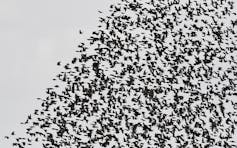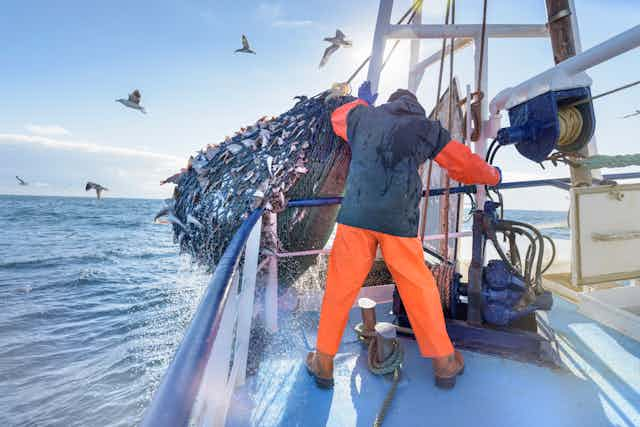The world’s travelling animals – marine turtles, whales, sharks, elephants, reptiles, wild cats, birds, and even insects – have entered a period of sharp decline, new research has found.
The first ever State of the World’s Migratory Species report, released today by the United Nations Convention on the Conservation of Migratory Species of Wild Animals, showed that the conservation status of many migratory species is getting worse.
The convention maintains a list of migratory species that are already in need of protection. The report shows that nearly half (44%) of these species are in further decline. More than one in five (or 22%) of the already threatened migratory species now face extinction. Nearly all (97%) of the migratory fish species that were already in need of protection are now threatened with extinction.
I work as a statistician researching the declines of wildlife populations. I have studied the report and agree that there is an urgent need for enhanced global cooperation and action to slow down, halt and reverse the declines in migratory species populations. We need to preserve the natural phenomenon of migration to ensure a healthy future for our planet.
Which species are listed?
The Convention on the Conservation of Migratory Species of Wild Animals is a global environmental treaty. It lists a migratory animal if it is endangered, or needs countries to co-operate in order to protect it. There are 4,508 species in the world that are migratory, and the convention lists 1,189. This report also calls for urgent action to protect about 400 additional globally endangered or near-threatened migratory species, primarily birds and fish, that are not currently covered by the convention.
Read more: Wildebeest migrations in East Africa face extinction. What must be done
My research has pointed out that migratory species undertake remarkable journeys that connect diverse habitats across the globe. Their travels are not only awe-inspiring natural spectacles, such as the great migration of the Serengeti-Mara wildebeest, zebra and gazelles, but also vital to the health and functioning of ecosystems worldwide.
The report found that the threatened migratory species occurring in Africa, Asia and North America are experiencing the fastest declines. Its findings should alarm us all.
Read more: Over-fishing is strangling a key protein source for West Africans
Fish: The world’s most threatened listed species are fish. Of the migratory species that the convention lists as needing some level of protection, 97% are under threat of extinction. Over-exploitation from hunting and fishing stands out as the most significant threat to migratory species globally. The report spotlights fishing bycatch as a huge problem. Bycatch occurs where commercial fishers of one type of fish kill other marine creatures that get caught in fishing nets.

Birds: Birds that migrate between Africa and Europe are under “intense hunting pressure” from humans in several countries in western and south-eastern Africa. The report points out that there is no coordinated monitoring of the threat to migratory birds in Africa. This limits the international community’s ability to understand how big the problem might be.
Migratory animals’ habitats are being destroyed
The report adds that the Serengeti-Mara ecosystem in Tanzania and Kenya is a “prime example” of how agriculture, roads, fences and settlements have caused habitat loss, degradation and fragmentation (breaking up a habitat into many smaller patches with a smaller total area).
In Africa, 79% of new cropland over the past few decades has been established by destroying the natural vegetation where many migratory animals lived, the report says. The report also points out that pollution and introducing alien invasive species into habitats of natural vegetation put pressure on these indigenous species.

This has affected some of the world’s largest free-ranging populations of migratory hoofed mammals, including blue wildebeest and plains zebra. These species support populations of apex predators including cheetah, lion and African wild dog. Long-term monitoring data on African wild dogs shows that their environment will become hotter as the climate warms. They will be less able to forage for food in higher temperatures and will raise fewer pups.
Why migratory species are important
Migratory species consume tons of food daily. This is digested and redistributed as they travel, transferring nutrients around the world. They also help with pollination, and with maintaining carbon-storing habitats through grazing. For example, deep-sea creatures, particularly tiny zooplankton, migrate from deep waters to the surface at night to feed on phytoplankton. They do this to avoid predators under the cover of darkness. This is the largest biomass migration on Earth. It’s not only a survival tactic but also plays a vital role in the carbon cycle, thus regulating Earth’s climate.
Protecting migratory species goes beyond conserving biodiversity; it is crucial for ensuring a healthier future for our planet. By protecting animals that journey, we can expand protected areas, enhance habitat connectivity, and tackle the root causes of overexploitation and pollution.
What to do about it
The report calls on countries to join forces to restore and protect damaged habitats. This includes expanding protected areas used by migratory species, taking down fences and making more effort to connect protected areas to each other. This will help migratory species to travel more easily. Stronger laws, enhanced international collaboration to curb illegal activities, and reducing bycatch in fisheries are urgently required, says the report.
It calls for action against environmental pollution, including steps to stop light and noise pollution. Strategies to cushion the impacts of climate change on migratory species are also needed.
This report marks a significant step towards creating a conservation roadmap for migratory species. It is a blueprint not only for reversing the declines in migratory species’ populations, but also for preserving the migration phenomenon itself.

